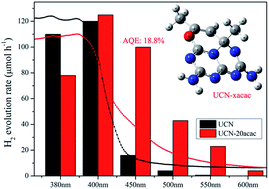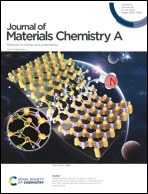Construction of a push–pull system in g-C3N4 for efficient photocatalytic hydrogen evolution under visible light†
Abstract
A facile “one-pot” method to improve the utilization of visible light using organic chemistry protocols is reported. The incorporation of acetylacetone (acac) into the conjugated polymer matrix g-C3N4 derived from urea (UCN) can tune the electronic structure effectively. As a result, the modified g-C3N4 showed a narrowed band gap and enhanced charge carrier migration and separation. Meanwhile, the high utilization ratio of visible light leads to efficient photocatalytic hydrogen evolution, and an apparent quantum efficiency (AQE) as high as 18.8% at 450 nm is achieved, exceeding that of most of the previously reported doped g-C3N4 photocatalysts. Furthermore, density functional theory (DFT) calculations certify the proposed structure of g-C3N4 by incorporation of acetylacetone and explain the enhanced ability to harvest photons due to the introduction of an electron push–pull system into the CN network. In addition, the incorporation of acac into g-C3N4 is also found to be applicable to other precursors (dicyandiamide and thiourea) through similar synthetic routes. Optical absorption under visible light is extended similarly, highlighting the universality of the current strategy. The work provides a route of organic chemistry to design and synthesize functional g-C3N4 with high photocatalytic performance.



 Please wait while we load your content...
Please wait while we load your content...